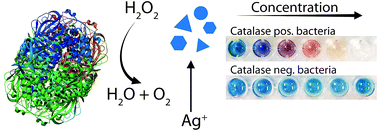Colorimetric detection of catalase and catalase-positive bacteria (E. coli) using silver nanoprisms†
Abstract
Portable, cost-effective and rapid sensing methods are desirable in areas such as environmental monitoring, food safety and point-of-care diagnostics. Colorimetric signals arising from plasmonic nanoparticles have been widely explored for the detection of biomarkers, ions and small molecules, but to a less extent for pathogens such as bacteria. Herein we explore the innate sensitivity of the formation of silver nanoprisms to hydrogen peroxide as a means to detect catalase activity, which is present in various bacteria associated with foodborne illnesses. The formation of large silver nanoprisms with plasmon resonance at long wavelengths is facilitated by the oxidative etching of the nanoparticles in the presence of a reducing agent and citrate. When enzymes such as catalase disrupts this redox balance, the morphology and size of the particles change to yield a color shift from blue to purple, red, orange and yellow. We show that the multi-color transition of Ag colloidal solutions can provide quantification of catalase and E. coli by eye in the range of 0–0.1 U and 106 to 107 cfu mL−1 (corresponding to 0.01–0.1 pM), respectively. We demonstrate the ability to detect E. coli on artificially contaminated lettuce leaf. When combined with pre-concentration and purification techniques, the visual readout may be useful for on-site analysis and monitoring of food and water quality.

- This article is part of the themed collection: Portable instrumentation & point of care technologies

 Please wait while we load your content...
Please wait while we load your content...